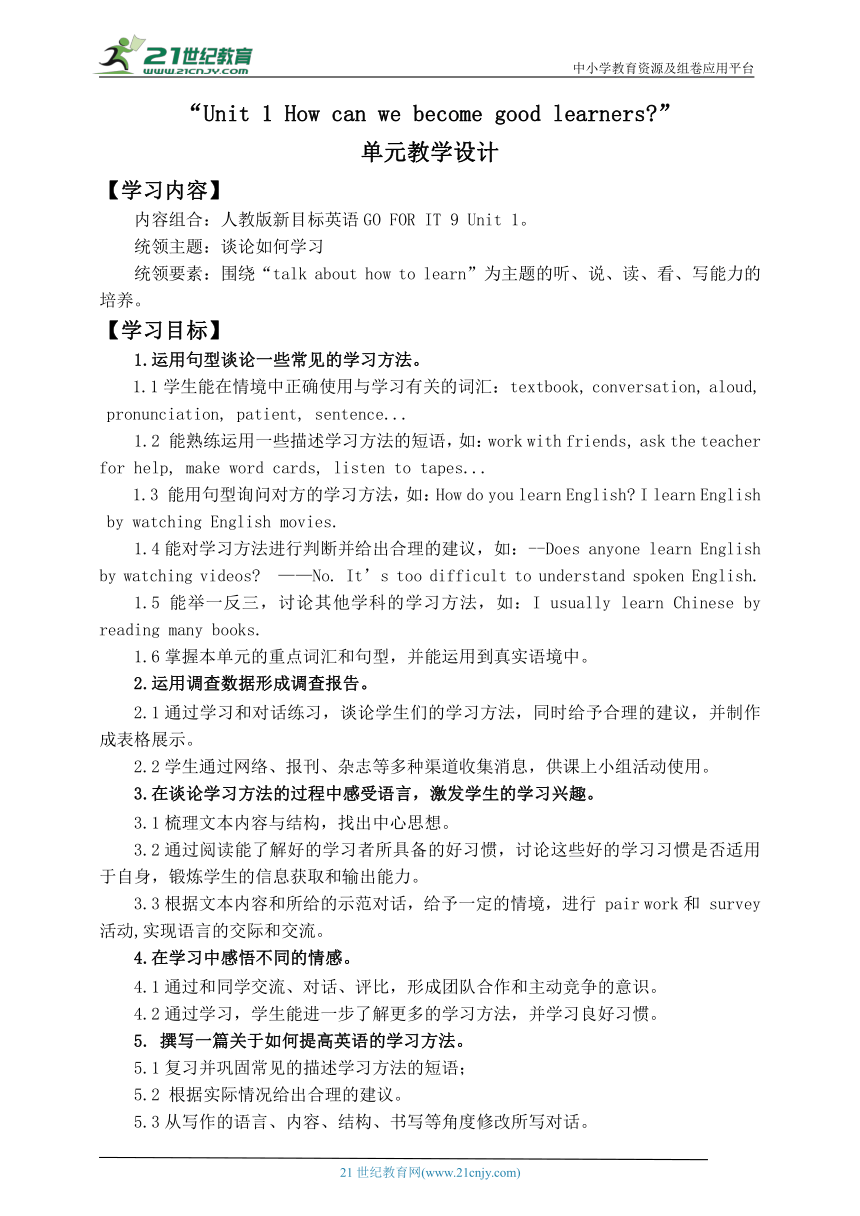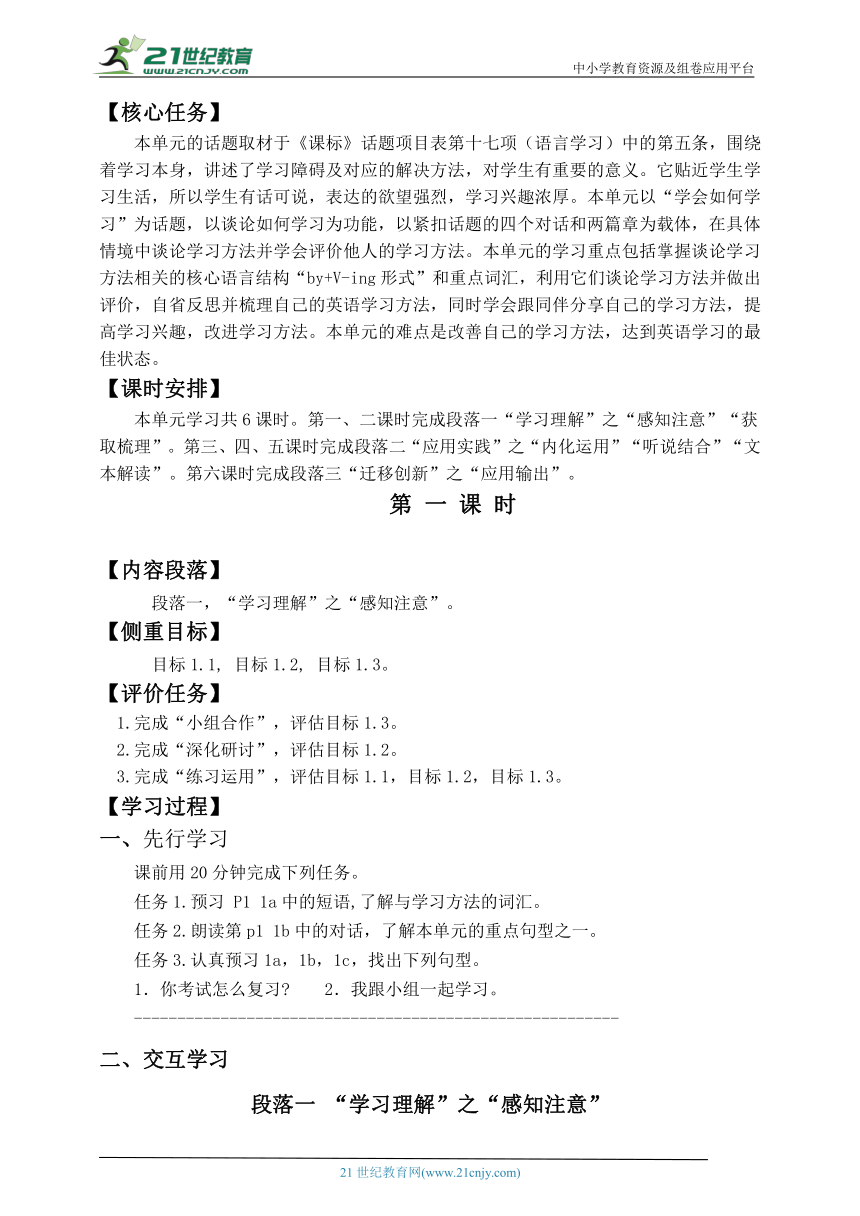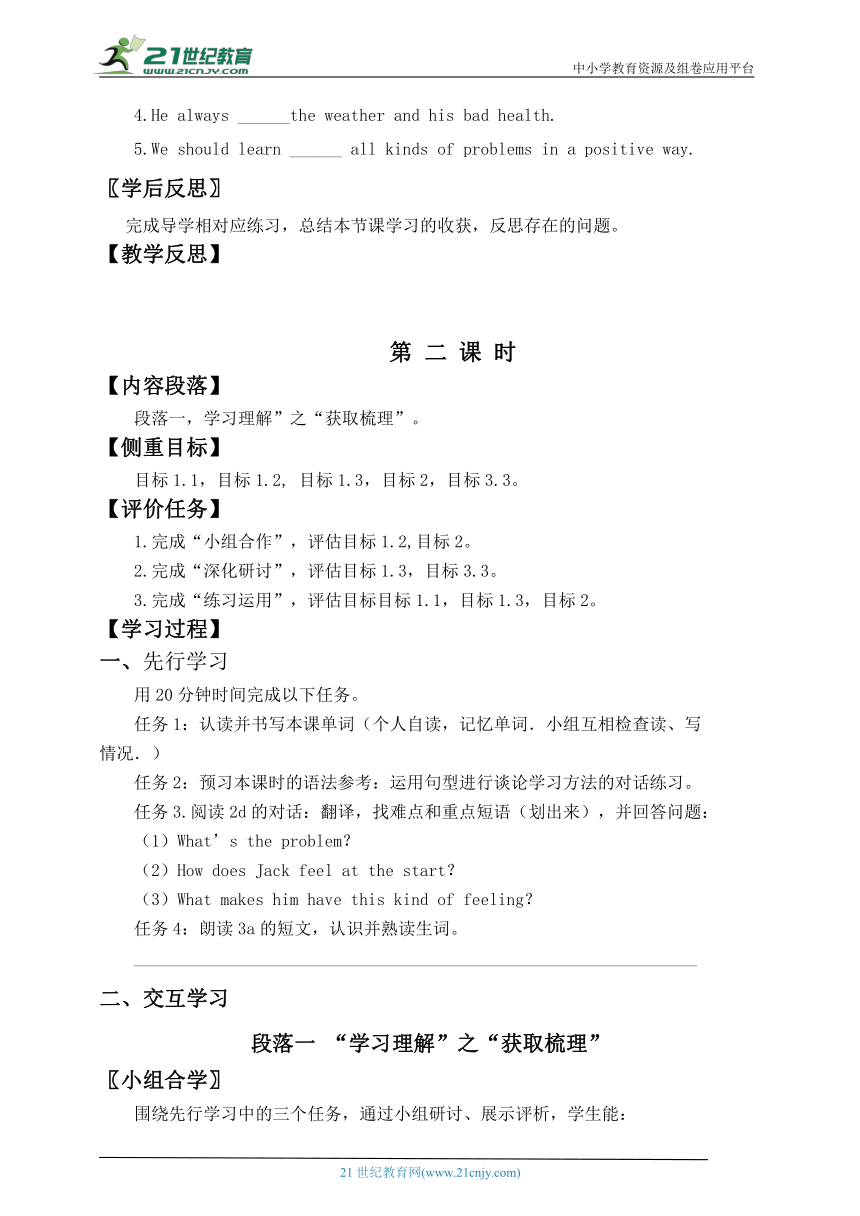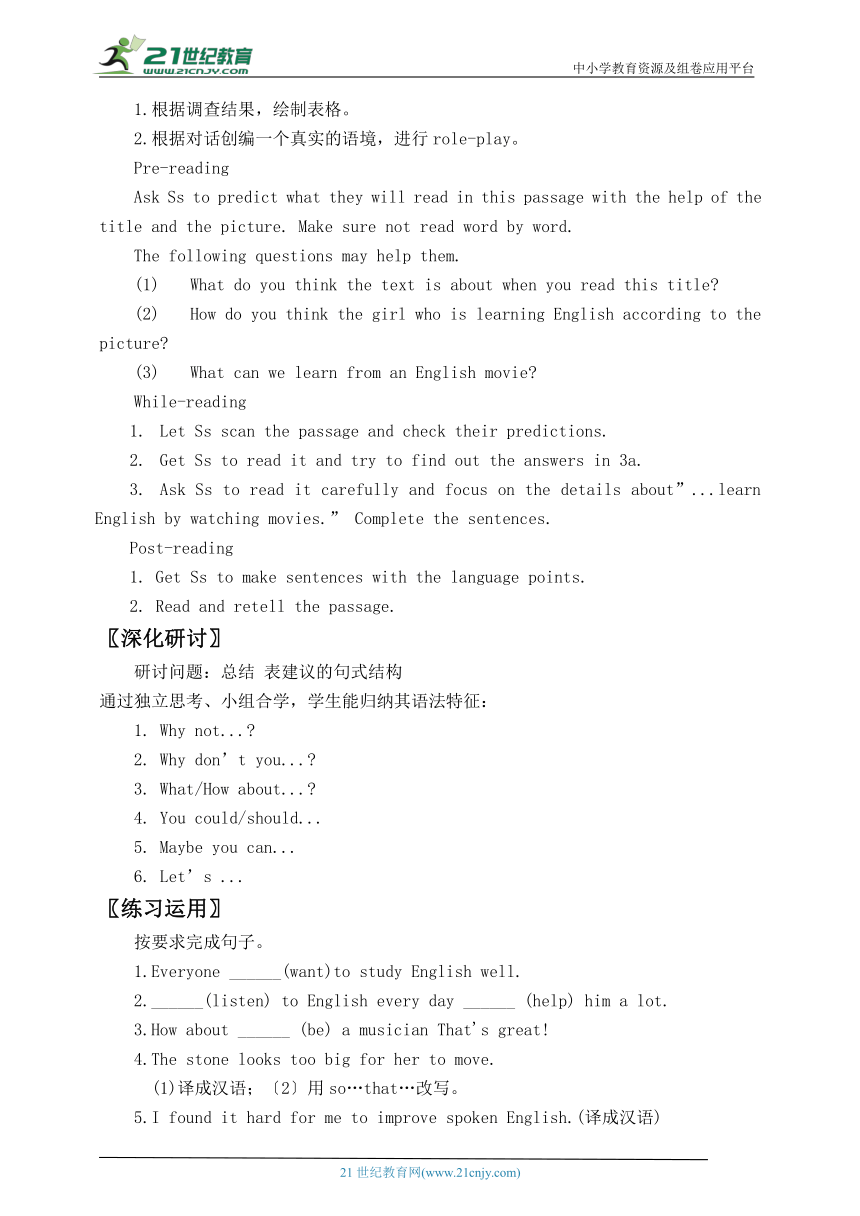Unit 1 How can we become good learners?单元教学设计 人教新目标(Go for it)版 九年级全册
文档属性
| 名称 | Unit 1 How can we become good learners?单元教学设计 人教新目标(Go for it)版 九年级全册 |  | |
| 格式 | doc | ||
| 文件大小 | 444.4KB | ||
| 资源类型 | 试卷 | ||
| 版本资源 | 人教新目标(Go for it)版 | ||
| 科目 | 英语 | ||
| 更新时间 | 2025-08-23 17:57:28 | ||
图片预览





文档简介
中小学教育资源及组卷应用平台
“Unit 1 How can we become good learners ”
单元教学设计
【学习内容】
内容组合:人教版新目标英语GO FOR IT 9 Unit 1。
统领主题:谈论如何学习
统领要素:围绕“talk about how to learn”为主题的听、说、读、看、写能力的培养。
【学习目标】
1.运用句型谈论一些常见的学习方法。
1.1学生能在情境中正确使用与学习有关的词汇:textbook, conversation, aloud, pronunciation, patient, sentence...
1.2 能熟练运用一些描述学习方法的短语,如:work with friends, ask the teacher for help, make word cards, listen to tapes...
1.3 能用句型询问对方的学习方法,如:How do you learn English I learn English by watching English movies.
1.4能对学习方法进行判断并给出合理的建议,如:--Does anyone learn English by watching videos ——No. It’s too difficult to understand spoken English.
1.5 能举一反三,讨论其他学科的学习方法,如:I usually learn Chinese by reading many books.
1.6掌握本单元的重点词汇和句型,并能运用到真实语境中。
2.运用调查数据形成调查报告。
2.1通过学习和对话练习,谈论学生们的学习方法,同时给予合理的建议,并制作成表格展示。
2.2学生通过网络、报刊、杂志等多种渠道收集消息,供课上小组活动使用。
3.在谈论学习方法的过程中感受语言,激发学生的学习兴趣。
3.1梳理文本内容与结构,找出中心思想。
3.2通过阅读能了解好的学习者所具备的好习惯,讨论这些好的学习习惯是否适用于自身,锻炼学生的信息获取和输出能力。
3.3根据文本内容和所给的示范对话,给予一定的情境,进行 pair work和 survey活动,实现语言的交际和交流。
4.在学习中感悟不同的情感。
4.1通过和同学交流、对话、评比,形成团队合作和主动竞争的意识。
4.2通过学习,学生能进一步了解更多的学习方法,并学习良好习惯。
撰写一篇关于如何提高英语的学习方法。
5.1复习并巩固常见的描述学习方法的短语;
5.2 根据实际情况给出合理的建议。
5.3从写作的语言、内容、结构、书写等角度修改所写对话。
【核心任务】
本单元的话题取材于《课标》话题项目表第十七项(语言学习)中的第五条,围绕着学习本身,讲述了学习障碍及对应的解决方法,对学生有重要的意义。它贴近学生学习生活,所以学生有话可说,表达的欲望强烈,学习兴趣浓厚。本单元以“学会如何学习”为话题,以谈论如何学习为功能,以紧扣话题的四个对话和两篇章为载体,在具体情境中谈论学习方法并学会评价他人的学习方法。本单元的学习重点包括掌握谈论学习方法相关的核心语言结构“by+V-ing形式”和重点词汇,利用它们谈论学习方法并做出评价,自省反思并梳理自己的英语学习方法,同时学会跟同伴分享自己的学习方法,提高学习兴趣,改进学习方法。本单元的难点是改善自己的学习方法,达到英语学习的最佳状态。
【课时安排】
本单元学习共6课时。第一、二课时完成段落一“学习理解”之“感知注意”“获取梳理”。第三、四、五课时完成段落二“应用实践”之“内化运用”“听说结合”“文本解读”。第六课时完成段落三“迁移创新”之“应用输出”。
第 一 课 时
【内容段落】
段落一,“学习理解”之“感知注意”。
【侧重目标】
目标1.1, 目标1.2, 目标1.3。
【评价任务】
1.完成“小组合作”,评估目标1.3。
2.完成“深化研讨”,评估目标1.2。
3.完成“练习运用”,评估目标1.1,目标1.2,目标1.3。
【学习过程】
一、先行学习
课前用20分钟完成下列任务。
任务1.预习 P1 1a中的短语,了解与学习方法的词汇。
任务2.朗读第p1 1b中的对话,了解本单元的重点句型之一。
任务3.认真预习1a,1b,1c,找出下列句型。
1.你考试怎么复习 2.我跟小组一起学习。
--------------------------------------------------------
二、交互学习
段落一 “学习理解”之“感知注意”
〖小组合学〗
一、围绕先行学习中的三个任务,通过小组交流、展示评析,学生能:
1.记住和理解本课生词,学习谈论学科学习方法的表达方式,使用How do you learn English I learn English by watching English movies.来对学习方法进行询问。
2.对描述学习方法的短语进行整合归纳。
3.用本课时的核心句型进行以下对话:
A:How do you learn English
B: I learn English by watching English movies.
A:That sounds difficult.
B: Well. Be patient. It takes time.
二、Listening
1.朗读1a中的短语,教师纠正错误读音,然后识记并将其和图片匹配。
2.仔细看1b中的题目,然后认真听录音,完成课本上1b的听力任务。
3.认真阅读2a中的信息,找出所听到的问题,集体核对答案。
4.认真阅读2b中的要求,再听一遍录音,配对问题答案。
5.用2a,2b中的信息仿照2c 的形式练习对话。
〖深化研讨〗
研讨问题:介词by的多种用法。
通过独立思考、小组合学,展示评析,学生能归纳出:
1.by+交通方式
2.by+方式、方法
3.by+sb 表被动,由…
4.by可以表示位置 come and sit by me.
5.by+时间 到…之前
6.短语: by oneself, by the way, go by, drop by, by now, day by day
〖练习运用〗
选词填空〔留意时态、语态和词形改变〕:①instead of;②have fun;③end up;④make mistakes;⑤laugh at;⑥later on;⑦be afraid of;⑧take notes;⑨look up;⑩deal with;⑾complain about
1.You may ______ the new words in the dictionary.
2.We ______ with the children in the park yesterday.
3.Be careful!Try your best not ______.
4.He always ______the weather and his bad health.
5.We should learn ______ all kinds of problems in a positive way.
〖学后反思〗
完成导学相对应练习,总结本节课学习的收获,反思存在的问题。
【教学反思】
第 二 课 时
【内容段落】
段落一,学习理解”之“获取梳理”。
【侧重目标】
目标1.1,目标1.2, 目标1.3,目标2,目标3.3。
【评价任务】
1.完成“小组合作”,评估目标1.2,目标2。
2.完成“深化研讨”,评估目标1.3,目标3.3。
3.完成“练习运用”,评估目标目标1.1,目标1.3,目标2。
【学习过程】
一、先行学习
用20分钟时间完成以下任务。
任务1:认读并书写本课单词(个人自读,记忆单词.小组互相检查读、写
情况.)
任务2:预习本课时的语法参考:运用句型进行谈论学习方法的对话练习。
任务3.阅读2d的对话:翻译,找难点和重点短语(划出来),并回答问题:
(1)What’s the problem?
(2)How does Jack feel at the start?
(3)What makes him have this kind of feeling?
任务4:朗读3a的短文,认识并熟读生词。
_________________________________________________________________
二、交互学习
段落一 “学习理解”之“获取梳理”
〖小组合学〗
围绕先行学习中的三个任务,通过小组研讨、展示评析,学生能:
1.根据调查结果,绘制表格。
2.根据对话创编一个真实的语境,进行role-play。
Pre-reading
Ask Ss to predict what they will read in this passage with the help of the title and the picture. Make sure not read word by word.
The following questions may help them.
What do you think the text is about when you read this title
How do you think the girl who is learning English according to the picture
What can we learn from an English movie
While-reading
Let Ss scan the passage and check their predictions.
Get Ss to read it and try to find out the answers in 3a.
Ask Ss to read it carefully and focus on the details about”...learn English by watching movies.” Complete the sentences.
Post-reading
Get Ss to make sentences with the language points.
Read and retell the passage.
〖深化研讨〗
研讨问题:总结 表建议的句式结构
通过独立思考、小组合学,学生能归纳其语法特征:
Why not...
Why don’t you...
What/How about...
You could/should...
Maybe you can...
Let’s ...
〖练习运用〗
按要求完成句子。
1.Everyone ______(want)to study English well.
2.______(listen) to English every day ______ (help) him a lot.
3.How about ______ (be) a musician That's great!
4.The stone looks too big for her to move.
(1)译成汉语;〔2〕用so…that…改写。
5.I found it hard for me to improve spoken English.(译成汉语)
〖学后反思〗
1.梳理和绘制学习本单元A部分的“the ways of English learning”话题思维导图。
2.完成导学作业,总结本节课的学习收获,反思学习中存在的问题。
【教学反思】
第 三 课 时
【内容段落】
段落二,“应用实践”之“内化运用”。
【侧重目标】
目标1.2,目标1.3,目标2.2,目标3.2,目标3.3。
【评价任务】
1.完成“小组合作”,评估目标1.2,目标1.3,目标 3.2。
2.完成“深度研学”,评估目标3.3。
3.完成“练习运用”,评估目标2.2。
【学习过程】
先行学习
课前用20分钟时间独立完成以下任务。
任务1:熟读并识记本单元的重点词汇。
任务2. 阅读Grammar Focus,并找出规律。
______________________________________
任务3:回忆情态动词should和反身代词的用法。
二、交互学习
段落二 “应用实践”之“内化运用”
〖小组合学〗
围绕先行学习中的三个任务,通过小组合学、展示评析,学生能:
1.Practice:look at the pictures, please make up conversations about them using the sentences in Grammar Focus.
2.read the sentences in Grammar Focus and find out the ways of talking about the learning methods and giving advice.
3.complete 4a alone.
4.ask Ss to work alone to write down the best advice to learn subjects.
5.Group work: make conversations with partners about learning methods.
〖深化研讨〗
研讨问题:谚语的表达方式。
通过独立思考、小组合学,学生能归纳其语法特征:
①It takes time.
②It’s a piece of time.
③ It serves you right.
④Use it or lose it.
⑤Practice makes perfect.
〖练习运用〗
按要求完成句子。
1.In order to improve your English,you should practice______ (speak)English every day.
2.Hurry!Or we'll be late!(同义句改写)
〔1〕If we______ ______ ,we ______ ______ late.〔If we______,we ______ ______ late.〕
〔2〕Uless we______ ,we ______ ______late.
3.Why not ______(have )a try →Why ______you ______(have) a try
4.______(Eat) more vegetables ______(stay) ______(安康).
5.Do you have any trouble______(get) along with your classmates
〖学后反思〗
完成导学作业,总结本节课的学习收获,反思学习中存在的问题。
【教学反思】
第 四 课 时
【内容段落】
段落二,“应用实践”之“听说结合”。
【侧重目标】
目标1,目标2。
【评价任务】
1.完成“小组合作”,评估目标1.6, 目标2.2,。
2.完成“练习运用”,评估目标2.1,目标2.2。
【学习过程】
一、先行学习
课前用20分钟时间独立完成以下任务:
任务1:参照预习单上的图片,认知单词及短语。
任务2:观察1a的句子,找出你学英语的难处。
二、交互学习
段落二 “应用实践”之“听说结合”
〖小组合学〗
围绕先行学习中的两个任务,通过小组合学、展示评析,学生能:
1.教师领读词组,强调个别单词的读音,学生快速记忆词组并且两人一组互相提问。
2.认真观察句子,并应用于真实语境。完成la。
3.听录音,根据内容填写Paul所遇到的学习问题。
4.再听录音,根据内容,补全其学习方法。
5.两人一组,根据听力材料,一人演绎Paul,一人演绎老师,角色扮演该对话,完成le。
〖练习运用〗
按要求完成句子。
1.Listen!How sweet that girl's ______(sound /voice /noise) is!
2.Don't shout ______(loud/aloud/loudly)at others!
3.I'm always______ tired because I always have______ work to do.(选择:A. much too;too much B. too much; much too C.many too; too many D. too many; many too)
〖学后反思〗
完成导学作业,总结本节课的学习收获,反思学习中存在的问题。
【教学反思】
第 五 课 时
【内容段落】
段落二,“应用实践”之“文本解读”。
【侧重目标】
目标3.1,目标4。
【评价任务】
1.完成“小组合学”评估目标3.1,目标4。
2.完成“练习运用”评估目标4。
【学习过程】
一、先行学习
课前用20分钟时间独立完成以下任务:
任务1:个人自读,记忆本课单词,读后小组互相检查单词阅读情况;
任务2:阅读2b短文,以小组为单位,共同找出本课中的重点内容,然后在组内交流探讨。
任务3:翻译。
1.但是你能否做好取决于你的学习习惯。
2.知识源于质疑。
3.通过写下关键字或画思维导图来记笔记。
4.即使你学习好,但如果你不是用它,你就会忘记它。
任务4:Read and draw a mind-map about the context of the passage.
________________________________________________________________
交互学习
段落二 “应用实践”之“文本解读”
〖小组合学〗
围绕先行学习1-4任务,通过小组合学,展示评析,学生能:
1.掌握本单元的重点词汇。
2.能正确运用本单元的句型和表达句式,并能应用到实际情境中去。
Pre-reading
2a: What good learning habits can you think of Make a list and discuss them with your partner.
Ask Ss to predict what they will read in this passage with the help of the title and the picture. Make sure not read word by word.
While-reading
Fast reading:
read for the general idea of 2b.
Read the passage and match the main idea with each paragraph.
Careful reading:
Read the passage quickly and answer the questions.
How many habits are mentioned in the passage And what are they
Then ask Ss to read carefully and complete 2c.
Post-reading
Complete 2d, 2e.
Summarize and retell it.
〖练习运用〗
选词填空〔留意时态、语态和词形改变〕:①instead of;②have fun;③end up;④make mistakes;⑤laugh at;⑥later on;⑦be afraid of;⑧take notes;⑨look up;⑩deal with;⑾complain about
6.______ in class is a good habit.
7.The sports meeting ______ with our school song.
8.She spent almost all her spare time playing the piano ,______ she became a great pianist.
9.Most children ______ their fathers.
10.______ taking a taxi, he went there on foot.
11.Don't ______ him. After all,he has realized his mistakes.
〖学后反思〗
通过自我评价,量化思考,学生能找出存在问题,调整学习策略。
【教学反思】
第 六 课 时
【内容段落】
段落三,“迁移创新”之“应用输出”。
【侧重目标】
目标3.1,目标4。
【评价任务】
1.完成“小组合学”评估目标3.1,目标4。
2.完成“练习运用”评估目标4。
【学习过程】
一、先行学习
课前用20分钟时间独立完成以下任务:
任务1:复习本单元重点词汇或短语。
任务2:运用相应的句式,谈论学科学习的困难以及相应的学习方法。
交互学习
段落三 “迁移创新”之“应用输出”
〖小组合学〗
围绕先行学习两个任务,通过小组合学,展示评析,学生能:
灵活应用重点词汇。
整理信息,构建连贯语篇,独立完成写作任务,提升语言书写能力。
Work on 3a: complete the chart.
Work on 3b: Write a letter to their friend.
Choose one of the Ss’ letters. Let the whole class read it together and correct mistakes.
〖练习运用〗
Self check 1, 2, 3.
三、后续学习
1.进行第一单元的检测。
【教学反思】
21世纪教育网 www.21cnjy.com 精品试卷·第 2 页 (共 2 页)
HYPERLINK "http://21世纪教育网(www.21cnjy.com)
" 21世纪教育网(www.21cnjy.com)
“Unit 1 How can we become good learners ”
单元教学设计
【学习内容】
内容组合:人教版新目标英语GO FOR IT 9 Unit 1。
统领主题:谈论如何学习
统领要素:围绕“talk about how to learn”为主题的听、说、读、看、写能力的培养。
【学习目标】
1.运用句型谈论一些常见的学习方法。
1.1学生能在情境中正确使用与学习有关的词汇:textbook, conversation, aloud, pronunciation, patient, sentence...
1.2 能熟练运用一些描述学习方法的短语,如:work with friends, ask the teacher for help, make word cards, listen to tapes...
1.3 能用句型询问对方的学习方法,如:How do you learn English I learn English by watching English movies.
1.4能对学习方法进行判断并给出合理的建议,如:--Does anyone learn English by watching videos ——No. It’s too difficult to understand spoken English.
1.5 能举一反三,讨论其他学科的学习方法,如:I usually learn Chinese by reading many books.
1.6掌握本单元的重点词汇和句型,并能运用到真实语境中。
2.运用调查数据形成调查报告。
2.1通过学习和对话练习,谈论学生们的学习方法,同时给予合理的建议,并制作成表格展示。
2.2学生通过网络、报刊、杂志等多种渠道收集消息,供课上小组活动使用。
3.在谈论学习方法的过程中感受语言,激发学生的学习兴趣。
3.1梳理文本内容与结构,找出中心思想。
3.2通过阅读能了解好的学习者所具备的好习惯,讨论这些好的学习习惯是否适用于自身,锻炼学生的信息获取和输出能力。
3.3根据文本内容和所给的示范对话,给予一定的情境,进行 pair work和 survey活动,实现语言的交际和交流。
4.在学习中感悟不同的情感。
4.1通过和同学交流、对话、评比,形成团队合作和主动竞争的意识。
4.2通过学习,学生能进一步了解更多的学习方法,并学习良好习惯。
撰写一篇关于如何提高英语的学习方法。
5.1复习并巩固常见的描述学习方法的短语;
5.2 根据实际情况给出合理的建议。
5.3从写作的语言、内容、结构、书写等角度修改所写对话。
【核心任务】
本单元的话题取材于《课标》话题项目表第十七项(语言学习)中的第五条,围绕着学习本身,讲述了学习障碍及对应的解决方法,对学生有重要的意义。它贴近学生学习生活,所以学生有话可说,表达的欲望强烈,学习兴趣浓厚。本单元以“学会如何学习”为话题,以谈论如何学习为功能,以紧扣话题的四个对话和两篇章为载体,在具体情境中谈论学习方法并学会评价他人的学习方法。本单元的学习重点包括掌握谈论学习方法相关的核心语言结构“by+V-ing形式”和重点词汇,利用它们谈论学习方法并做出评价,自省反思并梳理自己的英语学习方法,同时学会跟同伴分享自己的学习方法,提高学习兴趣,改进学习方法。本单元的难点是改善自己的学习方法,达到英语学习的最佳状态。
【课时安排】
本单元学习共6课时。第一、二课时完成段落一“学习理解”之“感知注意”“获取梳理”。第三、四、五课时完成段落二“应用实践”之“内化运用”“听说结合”“文本解读”。第六课时完成段落三“迁移创新”之“应用输出”。
第 一 课 时
【内容段落】
段落一,“学习理解”之“感知注意”。
【侧重目标】
目标1.1, 目标1.2, 目标1.3。
【评价任务】
1.完成“小组合作”,评估目标1.3。
2.完成“深化研讨”,评估目标1.2。
3.完成“练习运用”,评估目标1.1,目标1.2,目标1.3。
【学习过程】
一、先行学习
课前用20分钟完成下列任务。
任务1.预习 P1 1a中的短语,了解与学习方法的词汇。
任务2.朗读第p1 1b中的对话,了解本单元的重点句型之一。
任务3.认真预习1a,1b,1c,找出下列句型。
1.你考试怎么复习 2.我跟小组一起学习。
--------------------------------------------------------
二、交互学习
段落一 “学习理解”之“感知注意”
〖小组合学〗
一、围绕先行学习中的三个任务,通过小组交流、展示评析,学生能:
1.记住和理解本课生词,学习谈论学科学习方法的表达方式,使用How do you learn English I learn English by watching English movies.来对学习方法进行询问。
2.对描述学习方法的短语进行整合归纳。
3.用本课时的核心句型进行以下对话:
A:How do you learn English
B: I learn English by watching English movies.
A:That sounds difficult.
B: Well. Be patient. It takes time.
二、Listening
1.朗读1a中的短语,教师纠正错误读音,然后识记并将其和图片匹配。
2.仔细看1b中的题目,然后认真听录音,完成课本上1b的听力任务。
3.认真阅读2a中的信息,找出所听到的问题,集体核对答案。
4.认真阅读2b中的要求,再听一遍录音,配对问题答案。
5.用2a,2b中的信息仿照2c 的形式练习对话。
〖深化研讨〗
研讨问题:介词by的多种用法。
通过独立思考、小组合学,展示评析,学生能归纳出:
1.by+交通方式
2.by+方式、方法
3.by+sb 表被动,由…
4.by可以表示位置 come and sit by me.
5.by+时间 到…之前
6.短语: by oneself, by the way, go by, drop by, by now, day by day
〖练习运用〗
选词填空〔留意时态、语态和词形改变〕:①instead of;②have fun;③end up;④make mistakes;⑤laugh at;⑥later on;⑦be afraid of;⑧take notes;⑨look up;⑩deal with;⑾complain about
1.You may ______ the new words in the dictionary.
2.We ______ with the children in the park yesterday.
3.Be careful!Try your best not ______.
4.He always ______the weather and his bad health.
5.We should learn ______ all kinds of problems in a positive way.
〖学后反思〗
完成导学相对应练习,总结本节课学习的收获,反思存在的问题。
【教学反思】
第 二 课 时
【内容段落】
段落一,学习理解”之“获取梳理”。
【侧重目标】
目标1.1,目标1.2, 目标1.3,目标2,目标3.3。
【评价任务】
1.完成“小组合作”,评估目标1.2,目标2。
2.完成“深化研讨”,评估目标1.3,目标3.3。
3.完成“练习运用”,评估目标目标1.1,目标1.3,目标2。
【学习过程】
一、先行学习
用20分钟时间完成以下任务。
任务1:认读并书写本课单词(个人自读,记忆单词.小组互相检查读、写
情况.)
任务2:预习本课时的语法参考:运用句型进行谈论学习方法的对话练习。
任务3.阅读2d的对话:翻译,找难点和重点短语(划出来),并回答问题:
(1)What’s the problem?
(2)How does Jack feel at the start?
(3)What makes him have this kind of feeling?
任务4:朗读3a的短文,认识并熟读生词。
_________________________________________________________________
二、交互学习
段落一 “学习理解”之“获取梳理”
〖小组合学〗
围绕先行学习中的三个任务,通过小组研讨、展示评析,学生能:
1.根据调查结果,绘制表格。
2.根据对话创编一个真实的语境,进行role-play。
Pre-reading
Ask Ss to predict what they will read in this passage with the help of the title and the picture. Make sure not read word by word.
The following questions may help them.
What do you think the text is about when you read this title
How do you think the girl who is learning English according to the picture
What can we learn from an English movie
While-reading
Let Ss scan the passage and check their predictions.
Get Ss to read it and try to find out the answers in 3a.
Ask Ss to read it carefully and focus on the details about”...learn English by watching movies.” Complete the sentences.
Post-reading
Get Ss to make sentences with the language points.
Read and retell the passage.
〖深化研讨〗
研讨问题:总结 表建议的句式结构
通过独立思考、小组合学,学生能归纳其语法特征:
Why not...
Why don’t you...
What/How about...
You could/should...
Maybe you can...
Let’s ...
〖练习运用〗
按要求完成句子。
1.Everyone ______(want)to study English well.
2.______(listen) to English every day ______ (help) him a lot.
3.How about ______ (be) a musician That's great!
4.The stone looks too big for her to move.
(1)译成汉语;〔2〕用so…that…改写。
5.I found it hard for me to improve spoken English.(译成汉语)
〖学后反思〗
1.梳理和绘制学习本单元A部分的“the ways of English learning”话题思维导图。
2.完成导学作业,总结本节课的学习收获,反思学习中存在的问题。
【教学反思】
第 三 课 时
【内容段落】
段落二,“应用实践”之“内化运用”。
【侧重目标】
目标1.2,目标1.3,目标2.2,目标3.2,目标3.3。
【评价任务】
1.完成“小组合作”,评估目标1.2,目标1.3,目标 3.2。
2.完成“深度研学”,评估目标3.3。
3.完成“练习运用”,评估目标2.2。
【学习过程】
先行学习
课前用20分钟时间独立完成以下任务。
任务1:熟读并识记本单元的重点词汇。
任务2. 阅读Grammar Focus,并找出规律。
______________________________________
任务3:回忆情态动词should和反身代词的用法。
二、交互学习
段落二 “应用实践”之“内化运用”
〖小组合学〗
围绕先行学习中的三个任务,通过小组合学、展示评析,学生能:
1.Practice:look at the pictures, please make up conversations about them using the sentences in Grammar Focus.
2.read the sentences in Grammar Focus and find out the ways of talking about the learning methods and giving advice.
3.complete 4a alone.
4.ask Ss to work alone to write down the best advice to learn subjects.
5.Group work: make conversations with partners about learning methods.
〖深化研讨〗
研讨问题:谚语的表达方式。
通过独立思考、小组合学,学生能归纳其语法特征:
①It takes time.
②It’s a piece of time.
③ It serves you right.
④Use it or lose it.
⑤Practice makes perfect.
〖练习运用〗
按要求完成句子。
1.In order to improve your English,you should practice______ (speak)English every day.
2.Hurry!Or we'll be late!(同义句改写)
〔1〕If we______ ______ ,we ______ ______ late.〔If we______,we ______ ______ late.〕
〔2〕Uless we______ ,we ______ ______late.
3.Why not ______(have )a try →Why ______you ______(have) a try
4.______(Eat) more vegetables ______(stay) ______(安康).
5.Do you have any trouble______(get) along with your classmates
〖学后反思〗
完成导学作业,总结本节课的学习收获,反思学习中存在的问题。
【教学反思】
第 四 课 时
【内容段落】
段落二,“应用实践”之“听说结合”。
【侧重目标】
目标1,目标2。
【评价任务】
1.完成“小组合作”,评估目标1.6, 目标2.2,。
2.完成“练习运用”,评估目标2.1,目标2.2。
【学习过程】
一、先行学习
课前用20分钟时间独立完成以下任务:
任务1:参照预习单上的图片,认知单词及短语。
任务2:观察1a的句子,找出你学英语的难处。
二、交互学习
段落二 “应用实践”之“听说结合”
〖小组合学〗
围绕先行学习中的两个任务,通过小组合学、展示评析,学生能:
1.教师领读词组,强调个别单词的读音,学生快速记忆词组并且两人一组互相提问。
2.认真观察句子,并应用于真实语境。完成la。
3.听录音,根据内容填写Paul所遇到的学习问题。
4.再听录音,根据内容,补全其学习方法。
5.两人一组,根据听力材料,一人演绎Paul,一人演绎老师,角色扮演该对话,完成le。
〖练习运用〗
按要求完成句子。
1.Listen!How sweet that girl's ______(sound /voice /noise) is!
2.Don't shout ______(loud/aloud/loudly)at others!
3.I'm always______ tired because I always have______ work to do.(选择:A. much too;too much B. too much; much too C.many too; too many D. too many; many too)
〖学后反思〗
完成导学作业,总结本节课的学习收获,反思学习中存在的问题。
【教学反思】
第 五 课 时
【内容段落】
段落二,“应用实践”之“文本解读”。
【侧重目标】
目标3.1,目标4。
【评价任务】
1.完成“小组合学”评估目标3.1,目标4。
2.完成“练习运用”评估目标4。
【学习过程】
一、先行学习
课前用20分钟时间独立完成以下任务:
任务1:个人自读,记忆本课单词,读后小组互相检查单词阅读情况;
任务2:阅读2b短文,以小组为单位,共同找出本课中的重点内容,然后在组内交流探讨。
任务3:翻译。
1.但是你能否做好取决于你的学习习惯。
2.知识源于质疑。
3.通过写下关键字或画思维导图来记笔记。
4.即使你学习好,但如果你不是用它,你就会忘记它。
任务4:Read and draw a mind-map about the context of the passage.
________________________________________________________________
交互学习
段落二 “应用实践”之“文本解读”
〖小组合学〗
围绕先行学习1-4任务,通过小组合学,展示评析,学生能:
1.掌握本单元的重点词汇。
2.能正确运用本单元的句型和表达句式,并能应用到实际情境中去。
Pre-reading
2a: What good learning habits can you think of Make a list and discuss them with your partner.
Ask Ss to predict what they will read in this passage with the help of the title and the picture. Make sure not read word by word.
While-reading
Fast reading:
read for the general idea of 2b.
Read the passage and match the main idea with each paragraph.
Careful reading:
Read the passage quickly and answer the questions.
How many habits are mentioned in the passage And what are they
Then ask Ss to read carefully and complete 2c.
Post-reading
Complete 2d, 2e.
Summarize and retell it.
〖练习运用〗
选词填空〔留意时态、语态和词形改变〕:①instead of;②have fun;③end up;④make mistakes;⑤laugh at;⑥later on;⑦be afraid of;⑧take notes;⑨look up;⑩deal with;⑾complain about
6.______ in class is a good habit.
7.The sports meeting ______ with our school song.
8.She spent almost all her spare time playing the piano ,______ she became a great pianist.
9.Most children ______ their fathers.
10.______ taking a taxi, he went there on foot.
11.Don't ______ him. After all,he has realized his mistakes.
〖学后反思〗
通过自我评价,量化思考,学生能找出存在问题,调整学习策略。
【教学反思】
第 六 课 时
【内容段落】
段落三,“迁移创新”之“应用输出”。
【侧重目标】
目标3.1,目标4。
【评价任务】
1.完成“小组合学”评估目标3.1,目标4。
2.完成“练习运用”评估目标4。
【学习过程】
一、先行学习
课前用20分钟时间独立完成以下任务:
任务1:复习本单元重点词汇或短语。
任务2:运用相应的句式,谈论学科学习的困难以及相应的学习方法。
交互学习
段落三 “迁移创新”之“应用输出”
〖小组合学〗
围绕先行学习两个任务,通过小组合学,展示评析,学生能:
灵活应用重点词汇。
整理信息,构建连贯语篇,独立完成写作任务,提升语言书写能力。
Work on 3a: complete the chart.
Work on 3b: Write a letter to their friend.
Choose one of the Ss’ letters. Let the whole class read it together and correct mistakes.
〖练习运用〗
Self check 1, 2, 3.
三、后续学习
1.进行第一单元的检测。
【教学反思】
21世纪教育网 www.21cnjy.com 精品试卷·第 2 页 (共 2 页)
HYPERLINK "http://21世纪教育网(www.21cnjy.com)
" 21世纪教育网(www.21cnjy.com)
同课章节目录
- Unit 1 How can we become good learners.
- Section A
- Section B
- Unit 2 I think that mooncakes are delicious!
- Section A
- Section B
- Unit 3 Could you please tell me where the restroom
- Section A
- Section B
- Unit 4 I used to be afraid of the dark.
- Section A
- Section B
- Unit 5 What are the shirts made of?
- Section A
- Section B
- Review of Units 1-5
- Unit 6 When was it invented?
- Section A
- Section B
- Unit 7 Teenagers should be allowed to choose their
- Section A
- Section B
- Unit 8 It must belong to Carla.
- Section A
- Section B
- Unit 9 I like music that I can dance to.
- Section A
- Section B
- Unit 10 You're supposed to shake hands.
- Section A
- Section B
- Review of Units 6-10
- Unit 11 Sad movies make me cry.
- Section A
- Section B
- Unit 12 Life is full of the unexpected
- Section A
- Section B
- Unit 13 We're trying to save the earth!
- Section A
- Section B
- Unit 14 I remember meeting all of you in Grade 7.
- Section A
- Section B
- Review of Units 11-14
